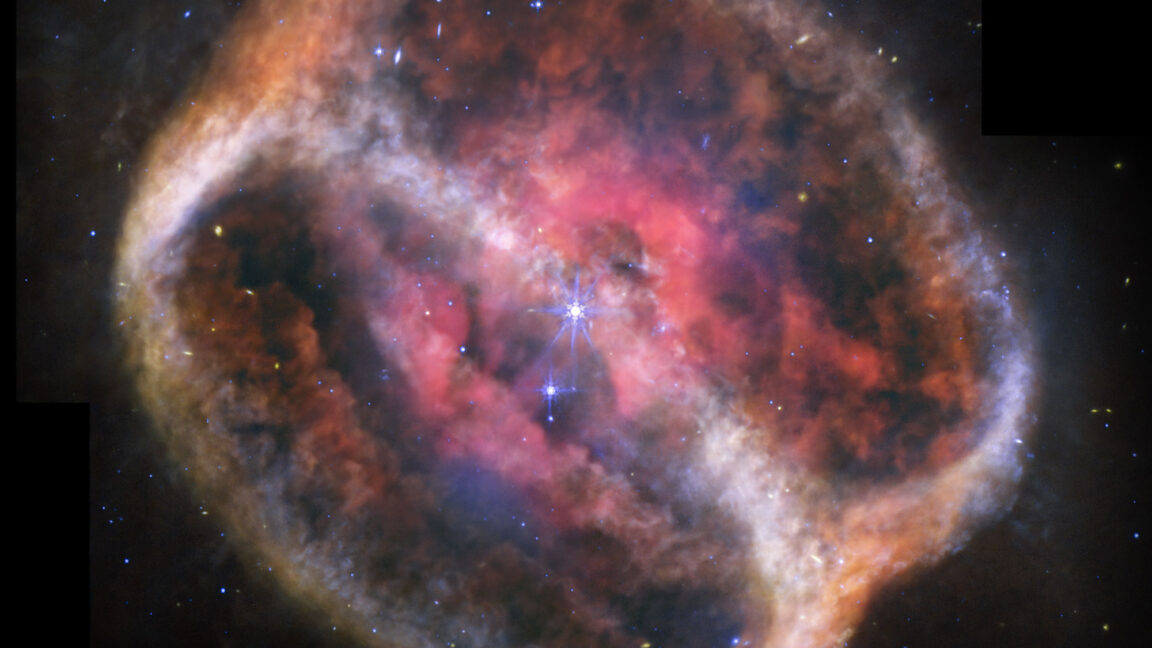Tuesday Telescope: Is the James Webb Space Telescope worth $10 billion?
Coming into focus
Tuesday Telescope: Is the James Webb Space Telescope worth $10 billion?
The rings are real, and they're spectacular.
Eric Berger
–
Apr 15, 2025 8:00 am
|
10
NASA’s James Webb Space Telescope has taken the most detailed image of planetary nebula NGC 1514 to date.
Credit:
NASA, ESA, CSA, STScI, Michael Ressler (NASA-JPL), Dave Jones (IAC)
NASA’s James Webb Space Telescope has taken the most detailed image of planetary nebula NGC 1514 to date.
Credit:
NASA, ESA, CSA, STScI, Michael Ressler (NASA-JPL), Dave Jones (IAC)
Story text
Size
Small
Standard
Large
Width
*
Standard
Wide
Links
Standard
Orange
* Subscribers only
Learn more
Welcome to the Tuesday Telescope. There is a little too much darkness in this world and not enough light—a little too much pseudoscience and not enough science. We’ll let other publications offer you a daily horoscope. At Ars Technica, we’ll take a different route, finding inspiration from very real images of a universe that is filled with stars and wonder.
Was the James Webb Space Telescope worth it?
Well, $10 billion is a lot of money. Even when spread over a couple of decades, that's still a huge chunk of NASA's annual science budget. (And given the recent Trump administration attack on NASA's science budget, money is about to get a whole lot tighter.)
However, it is difficult to put a price on advancing our species' understanding of the natural world and the wide Universe we're swimming in. And Webb is doing an amazing job of that.
In 2009, NASA launched the Wide-field Infrared Survey Explorer, or WISE, mission to make infrared observations. This was the latest in a line of space-based infrared observatories, and it cost about 3 percent as much as the Webb telescope.
Two infrared views of NGC 1514. At left is an observation from NASA’s Wide-field Infrared Survey Explorer (WISE).
Credit:
NASA, ESA, CSA, STScI, NASA-JPL, Caltech, UCLA, Michael Ressler (NASA-JPL), Dave Jones (IAC)
Two infrared views of NGC 1514. At left is an observation from NASA’s Wide-field Infrared Survey Explorer (WISE).
Credit:
NASA, ESA, CSA, STScI, NASA-JPL, Caltech, UCLA, Michael Ressler (NASA-JPL), Dave Jones (IAC)
Today's photo concerns the planetary nebula NGC 1514. In 2010, using the WISE telescope, NASA project scientist Mike Ressler discovered "rings" around the planetary nebula. Now, thanks to Webb, the rings—which are likely composed of small dust grains, heated by ultraviolet light from a white dwarf star—can be seen clearly. And, oh my, they're spectacular.
The clarity in the Webb photo, compared to what came before, is remarkable. So, is seeing the Universe in a new light worth $10 billion? I certainly think so, but I'm writing a weekly story called the Tuesday Telescope, so it's safe to say I am biased.
Source: NASA, ESA, CSA, STScI, Michael Ressler (NASA-JPL), Dave Jones (IAC)
Do you want to submit a photo for the Daily Telescope? Reach out and say hello.
Eric Berger
Senior Space Editor
Eric Berger
Senior Space Editor
Eric Berger is the senior space editor at Ars Technica, covering everything from astronomy to private space to NASA policy, and author of two books: Liftoff, about the rise of SpaceX; and Reentry, on the development of the Falcon 9 rocket and Dragon. A certified meteorologist, Eric lives in Houston.
10 Comments


